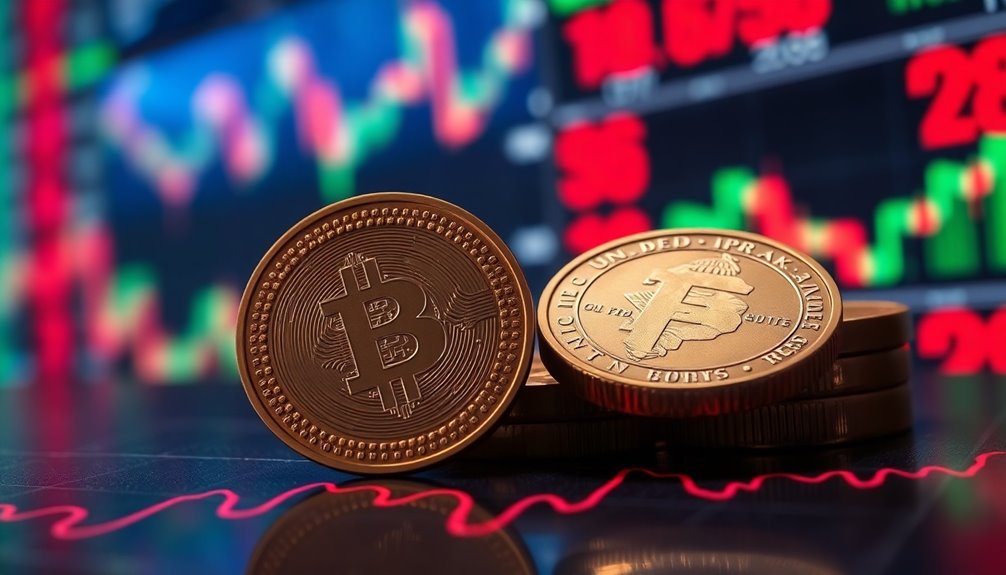A pegged currency is one that you tie to a major stable currency, like the US Dollar or Euro. This connection helps stabilize its value, reducing fluctuations in the exchange rate. Central banks actively intervene to maintain this peg, using foreign currency reserves to either support or restrain the domestic currency's value. While pegging can enhance economic predictability and attract foreign investment, it may limit your country's monetary policy flexibility. Managing a peg effectively is crucial, especially in the face of external shocks. If you'd like to explore how pegged currencies work in different economies, keep going!
Key Takeaways
- A pegged currency is tied to another major currency, like the US Dollar, to stabilize its value against fluctuations.
- Central banks actively manage foreign exchange markets to maintain the peg through buying or selling foreign currency reserves.
- Pegging enhances economic predictability and trade but limits monetary policy flexibility due to the need for constant intervention.
- Pegged currencies can reduce exchange rate volatility, but they remain vulnerable to external shocks and speculative attacks.
- Key economic indicators like GDP and inflation significantly influence the sustainability of a pegged currency system.
Currency Stabilization Mechanism

When a country pegs its currency to another, it relies on various currency stabilization mechanisms to maintain that fixed exchange rate.
Central banks actively intervene in the foreign exchange market, buying or selling the domestic currency to keep it within the target range relative to the anchor currency. When you sell foreign currency from reserves and buy back domestic money, you increase demand for it, stabilizing its value. This is especially important as maintaining foreign reserves is crucial for a successful pegged exchange rate system.
On the flip side, buying foreign currency while selling domestic currency can lead to depreciation if your currency appreciates too much.
To support this peg, maintaining large foreign exchange reserves is crucial, but frequent interventions can quickly deplete them, making it vital to manage these reserves carefully.
Currency Value Alignment Explained

Understanding currency value alignment through pegging is essential for grasping how fixed exchange rates operate. When a currency is pegged, it's tied to another stable currency, usually the USD or EUR, to stabilize its value. This alignment helps prevent excessive under- or over-valuation, enhancing economic predictability. However, maintaining this peg requires active intervention by the central bank in foreign exchange markets, which can deplete foreign reserves if not managed effectively. Economic factors like inflation rates play a crucial role; differing inflation can lead to currency depreciation, challenging the peg's sustainability. Ultimately, a well-maintained peg boosts trade and investment by providing stability, but it also limits your country's monetary policy flexibility, creating potential economic tensions. A fixed rate is maintained through government or central bank intervention, which is crucial for the peg's effectiveness.
Mechanism of Currency Fixing

The mechanism of currency fixing relies heavily on the intervention of central banks to maintain a stable exchange rate. Central banks use open market operations to manage foreign currency demand. When there's excess demand for foreign currency, they sell from reserves and buy back domestic currency. Conversely, if the domestic currency's value is too strong, they buy foreign currency and sell their own to lower its value. These actions create artificial demand or supply to adjust the exchange rate. Additionally, central banks may intervene in the foreign exchange market to stabilize their currency, often coordinating with other institutions. Effective reserve management is critical, as frequent interventions can deplete reserves, impacting the peg's sustainability. Pegging to the U.S. dollar is a common strategy employed by many nations to ensure stability in their own currency.
Pros and Cons

While pegged currencies offer several advantages, they also come with notable drawbacks that can impact a nation's economy.
You'll find that exchange rate stability reduces risks for foreign investors, making international trade easier and boosting real incomes. It helps control inflation and builds investor confidence, making your country's exports more competitive. This stability is often achieved through the intervention of central banks in the foreign exchange market.
However, you'll also face challenges. Maintaining the peg limits your monetary policy control, and defending it can deplete foreign reserves unsustainably.
A pegged currency is vulnerable to external shocks and can attract speculative attacks if it strays from market equilibrium. If the peg is set too high, it risks chronic trade deficits and inflation, potentially leading to a collapse.
Balancing these pros and cons is crucial.
Currency Peg vs. Float

When comparing a pegged currency to a floating exchange rate, it's essential to recognize the distinct advantages and challenges each system presents.
Pegged currencies, like the Saudi Riyal tied to the US dollar, offer stability and predictability, making them attractive to foreign investors and helping control inflation. However, they require active management by central banks, which can lead to frequent government intervention. Additionally, currency strength is influenced by factors such as inflation rates and interest rates, which can affect the long-term viability of a pegged system.
In contrast, floating exchange rates, such as the US dollar, adjust automatically based on market forces, providing flexibility and reflecting economic conditions. Yet, this can create uncertainty and volatility, impacting businesses and investors.
Ultimately, the choice between a peg and a float depends on a country's economic goals and trade relationships.
Market Volatility Concerns

Market volatility concerns arise prominently in the context of pegged currencies, especially as central banks grapple with maintaining stability.
While pegged currencies can reduce exchange rate volatility, this effect largely depends on the size of the currency network and the choice of anchor currency. High inflation can undermine stability, increasing volatility.
Central banks need substantial foreign reserves to defend the peg, and frequent interventions can deplete these reserves, making the currency vulnerable to shocks. The continuous increase in currency supply can lead to inflation risks, further complicating the management of a pegged exchange rate.
Market sentiment plays a crucial role too; speculation can trigger significant exchange rate movements if investors doubt the peg's sustainability.
Ultimately, these factors can complicate a country's economic management, limiting its ability to adapt to downturns or inflationary pressures.
Global Pegging Initiatives Update

As the landscape of global finance evolves, pegged currencies are gaining attention through various initiatives aimed at enhancing their stability and utility.
You might notice that around $170 billion worth of stablecoins, mainly pegged to the US dollar, are circulating globally, with 80% of this activity occurring outside the United States.
These stablecoins are increasingly used for remittance payments and accessing dollars in regions like Europe and Southeast Asia. Additionally, the anticipated interest rate cuts by the US Federal Reserve may further influence the attractiveness of pegged currencies linked to the dollar.
However, the rise of stablecoins comes with regulatory concerns, prompting companies to seek compliance.
Additionally, US tariffs could shift trade dynamics, influencing the value of currencies tied to the dollar.
As international trade partners adapt, these changes will further impact the landscape of pegged currencies.
Monitor Economic Indicators Regularly

Monitoring economic indicators regularly is key to understanding the stability and performance of pegged currencies. By keeping an eye on GDP, you can gauge a country's economic health. The Consumer Price Index (CPI) helps you assess inflation, while unemployment rates reveal labor market conditions.
Tracking the Consumer Confidence Index gives insights into spending patterns that drive economic growth. Leading indicators like manufacturers' orders can forecast future economic performance, while lagging indicators confirm past trends. Understanding these types of economic indicators allows you to make informed investment decisions and understand policy formulations. By analyzing these trends and comparing them across countries, you can gain predictive insights into economic patterns, all of which are crucial for navigating the complexities of pegged currencies.
Frequently Asked Questions
How Does a Pegged Currency Affect International Trade?
A pegged currency stabilizes exchange rates, making international trade more predictable for you.
You won't need to hedge against currency fluctuations, which simplifies your business planning. This stability can enhance your competitiveness abroad and attract foreign investment.
However, if the peg is misaligned, it could lead to trade deficits or inflation, affecting your purchasing power.
Ultimately, a pegged currency can create opportunities but also poses risks to economic balance.
Can a Pegged Currency Lead to Inflation?
A pegged currency can lead to inflation, especially if the peg isn't maintained properly.
You'll notice that if the central bank struggles to defend the peg, it might resort to printing more money, which can increase inflation.
Additionally, if external shocks hit the anchor currency, your economy could feel the impact.
Ultimately, while pegged currencies often aim to stabilize prices, poor management can result in inflationary pressures that you'll need to watch out for.
What Countries Currently Use a Pegged Currency?
If you're curious about which countries use a pegged currency, you'll find several examples.
Bahrain, Hong Kong, and Qatar peg their currencies to the US dollar, while Benin and Burkina Faso peg to the Euro through the West African CFA franc.
Bhutan and Nepal peg to the Indian rupee, and several Pacific nations peg to the New Zealand dollar.
Each of these arrangements aims to stabilize their economies and exchange rates.
How Is a Currency Peg Established Initially?
Imagine a country like Xlandia, which decides to peg its currency to the US dollar.
To establish the peg, you'd first analyze trade relationships and economic stability. Then, you'd fix the exchange rate, possibly using a crawling peg for flexibility.
Your central bank would intervene as needed, buying or selling currency to maintain the peg. Regular monitoring of economic conditions ensures adjustments can be made to uphold stability and predictability in your economy.
What Happens if a Pegged Currency Is Abandoned?
If you abandon a pegged currency, you'll likely face significant repercussions.
The currency may depreciate sharply, leading to increased inflation and unemployment. Your country's GDP could contract, and investor confidence might wane, causing market instability.
You'll also see greater exchange rate volatility and potential banking crises.
In the aftermath, managing economic recovery will be challenging, requiring fiscal reforms and careful monetary policies to stabilize the situation and rebuild trust in your currency.
Conclusion
In conclusion, understanding pegged currencies can really help you navigate the complex world of finance. By keeping a close eye on economic indicators and knowing the pros and cons, you can make informed decisions. While a stable currency can smooth out the bumps on the road, it's essential to remember that nothing's set in stone. So, stay alert and adapt as needed, because in the world of currencies, it's always good to keep your ear to the ground.









